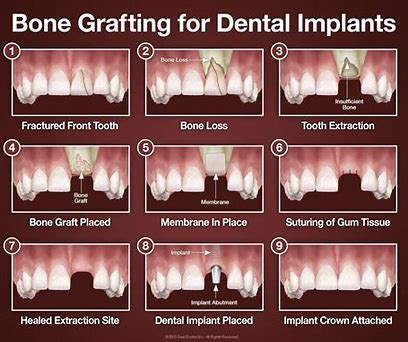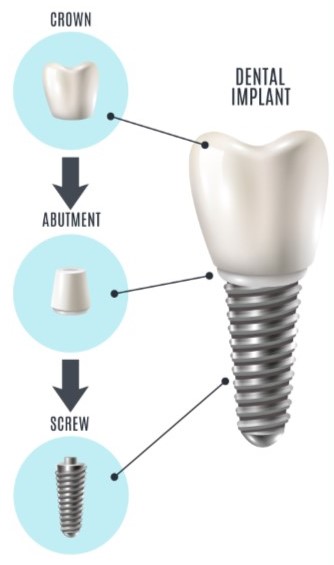Bone grafting in dentistry is a surgical procedure that involves replacing missing or damaged bone with bone tissue from another part of the patient’s body, a donor, or a bone substitute material. This technique is commonly used for dental implant placement or to repair bone loss due to trauma or infection. Bone grafting is a standard treatment in dentistry as it helps restore the function and aesthetics of the jaw.

Types of Materials Used for Grafting in Dentistry
In dentistry, a variety of materials can be used for grafting, including:
1. Autografts:
Autografts are the gold standard for bone grafting because they come from the patient’s own body. They provide the best outcomes because the body does not reject its tissue. Autografts can be harvested from different areas of the patient’s body, but the most commonly harvested site is the iliac crest, located at the top of the pelvis.
2. Allografts:
Allografts are bone grafts consisting of bone taken from a deceased individual which undergoes various sterilization and processing steps to reduce the risk of infection and rejection. These grafts are readily available and do not need a secondary surgery to harvest tissue. Allografts are commonly used in cases where the patient is unable to undergo an autograft surgery.
3. Xenografts:
Xenografts are bone grafts taken from a non-human source which has undergone processing and sterilization to minimize the risk of infection and rejection. Common sources of xenografts are bovine or equine bones. Xenografts are also used in cases where the patient cannot undergo an autograft procedure.
4. Synthetic bone graft substitutes:
These are man-made materials that mimic the properties of natural bone, such as calcium phosphate or hydroxyapatite. Synthetic bone grafts do not incur a risk of disease transmission, and the grafts can be modified and designed to promote growth factors and tissue regeneration.
Procedure

The bone grafting procedure in dentistry involves several steps, including:
1. Anesthesia: The patient is given anesthesia to ensure they are comfortable and pain-free throughout the procedure.
2. Bone harvesting: If an autograft is used, bone tissue is harvested from a donor site, such as the hip or leg.
3. Bone graft placement: The harvested bone tissue or bone graft substitute is then placed in the area where bone regeneration is needed.
4. Securing the graft: The graft site is secured with pins, screws or a plate to ensure the graft stays in place while new bone tissue grows around it.
5. Post-operative care: Following the surgery, the patient is monitored and advised to follow post-operative care guidelines carefully.
Advantages of Bone Grafting in Dentistry
Bone grafting in dentistry has several advantages, including:
1. Improved implant success rate: Bone grafting increases the likelihood of a successful dental implant procedure by providing the necessary amount of bone to support the implant.
2. Enhanced aesthetics: Bone grafting can improve the appearance of the smile by increasing the volume of bone and filling out hollow areas in the jaw.
3. Better functionality: Bone grafting restores the lost bone and allows patients to chew and speak with more confidence and ease.

Disadvantages of Bone Grafting in Dentistry
Bone grafting in dentistry also has some disadvantages, including:
1. Longer treatment time: Bone grafting can add a few months to a year of extra waiting time before proceeding with dental implant surgery.
2. Increased surgical risks: Bone grafting involves surgery, which can cause complications such as infection or bleeding.
3. Additional cost: The cost of bone grafting can be higher than other types of dental treatments, particularly if the graft material is expensive or needs a second procedure to harvest.
Indications and Contraindications
Indications for Bone Grafting in Dentistry:
1. Tooth loss: Bone grafting can help to rebuild or regenerate lost bone in areas where teeth have been lost or extracted.
2. Gum disease: In cases where gum disease has caused bone loss, bone grafting can restore lost bone tissue.
3. Dental implants: Bone grafting is often used to strengthen the jawbone before dental implant placement.
4. Ridge preservation: If you are having a tooth extracted and plan to get an implant in the future, bone grafting can help preserve the ridge of the jawbone until the implant can be placed.
Contraindications for Bone Grafting in Dentistry:
1. Infection: Active infection in the area to be treated can increase the risk of complications and may make bone grafting inappropriate.
2. Severe medical conditions: Patients with certain medical conditions, such as uncontrolled diabetes or significant heart or lung problems, may not be good candidates for bone grafting.
3. Smoking: Smoking can impair the healing process and increase the risk of infection, making bone grafting less effective.
4. Periodontal disease: If periodontal disease has caused extensive bone loss throughout the mouth, bone grafting may not be feasible or effective.
5. Poor oral hygiene: Patients with poor oral hygiene may not be good candidates for bone grafting, as the risk of infection and complications may be higher. It’s important to work with your dentist to address any underlying health or dental issues before undergoing a bone grafting procedure.
Conclusion
Bone grafting is a valuable procedure in dentistry that allows for a stable base for dental implants and treats bone loss due to trauma and infection. The choice of bone graft material should be based on the patient’s individual needs and the complexity of the procedure. Consulting a qualified dentist is necessary to ensure that bone grafting is the right treatment.
FAQs
Here are some frequently asked questions about bone grafting in dentistry:
Q: What is bone grafting in dentistry?
A: Bone grafting is a dental procedure that involves adding bone tissue to an area of the jawbone that has lost volume or density due to tooth loss, infection, or trauma. The added bone tissue can provide support for implants or other restorations and improve the overall function and appearance of the mouth.
Q: Why might I need a bone graft in dentistry?
A: A bone graft may be necessary if you have lost bone tissue in the jaw due to tooth loss, periodontal disease, or injury. This can make it difficult or impossible to place dental implants or operate other restorative treatments. Bone grafting can help to rebuild or regenerate lost bone, making it possible to have a successful restoration.
Q: What is the procedure for getting a bone graft in dentistry?
A: The procedure for getting a bone graft in dentistry will depend on the location and extent of the bone loss. In general, the dentist will create a small incision in the gum tissue to expose the underlying bone. Then, bone tissue from another part of your body, a donor, or synthetic material will be transplanted into the affected area. The graft will be secured in place, and the incision will be closed with stitches.
Q: How long does it take to recover from a bone grafting procedure?
A: Recovery time will vary depending on the individual and the extent of the procedure. You may experience swelling, discomfort, or some bleeding in the days following the surgery. Most patients can return to their normal activities within a few days, but it can take several months for the bone graft to heal fully.
Q: What are the risks associated with bone grafting in dentistry?
A: As with any surgical procedure, there are some risks associated with bone grafting. These may include infection, bleeding, nerve damage, and rejection or failure of the graft. However, the risk of complications is generally low, and most patients experience successful outcomes from the procedure.

